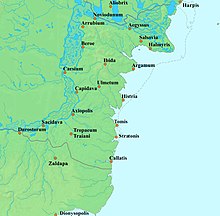Scythia Minor
Scythia Minor , "Smaller Scythia" ( ancient Greek Μικρά Σκυθία 'Mikrá Skythía ), referred to in ancient times the region that was framed to the west and north by the Danube and the Black Sea in the east. The borders correspond roughly to today's Dobruja , which is partly in Romania and Bulgaria .
The earliest description of the region can be found in Herodotus , who started the Scythian settlement area north of the Danube Delta . In a Roman inscription from the 2nd century BC BC, a decree from Histria in honor of Agathocles, the area was already called Scythia; the first use of the name “Scythia Minor” ( Mikrá Skythia ) is found in Strabon's geography .
From the 7th century BC Several Greek colonies were established along the Black Sea coast. The first written Greek reports stated that the area was originally inhabited by Thracians , first in the form of Geten and later by Dacians . In later times, the region fell victim to Celtic and Scythian invasions. For a time it was part of the Kingdom of Dacia . Then it was conquered by the Roman Empire and part of the Roman province of Moesia inferior (Lower Moesia ). In the course of the reforms of Diocletian , the region was separated from the province of Moesia ( Moesia ) and reclassified to the separate province "Scythia", which was part of the diocese of Thrace . After the division of the empire in 395 , the province was added to the Eastern Roman Empire . It kept the name Scythia Minor until the region was lost to the empire in the 7th century when the Slavs took over the Balkans . Then the classic name was replaced by the Slavic Dobruja .
literature
- Konrad Kretschmer : Scythia minor. In: Paulys Realencyclopadie der classischen Antiquity Science (RE). Volume II A, 1, Stuttgart 1921, Col. 946.
